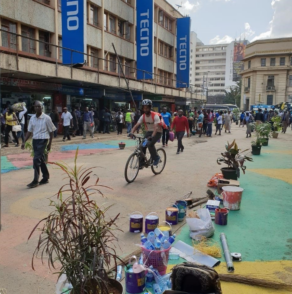This course builds on the work of several fall quarter projects, including the Connectivity Element for Comprehensive Plan and Community Place-Making, and integrates, advances or deepens the findings of those projects. Read the final student report delivered to the local gov/community partner. Livable City Year Contact Info Teri Thomson Randall Program Manager terir@uw.edu 206.221.9240 University […]
Discipline: Urban Design
City of Tigard Paid Parking Policy
The Southwest Corridor Plan introduces MAX light rail to outer Southwest Portland, Tigard, and other Portland-area suburbs along the I-5 corridor. As part of this project, TriMet and the city of Tigard are investigating a Park and Ride facility near the MAX stop planned for Tigard’s central business district (CBD). This report examines the viability […]
Mitigating the Impacts for Port-Related Vulnerabilities
The City recognizes that many in the community are simply unable to prepare themselves for a disaster or major emergency. This project would provide an assessment of the City’s neighborhoods, particularly South End, Eastside and Hilltop, to identify potential locations in each for emergency sheltering and supply storage (e.g., community centers, schools, churches, etc.). Read […]
Read More… from Mitigating the Impacts for Port-Related Vulnerabilities
Planning and Development: Community Planning Implementation: Social Media
PDS has been seeking to increase the diverse methods of communication the department uses to reach citizens and to involve them in the decision-making process. The intent is to create a social media presence that reflects the mission of PDS and to train staff on how to most effectively utilize social media to have the […]
Read More… from Planning and Development: Community Planning Implementation: Social Media
Aurburn Alleyway
Our project involves the redesign of the alley located between the Auburn Avenue Theater and Auburn Arts and Culture Center and the surrounding landscape area to provide the community with functional spaces that relates to the programmatic components of adjacent businesses. Envisioned is a revitalization action plan that would produce a model for public gathering, […]
Rethinking the Edge City of Leander
Leander, Texas faces sustainability challenges associated with an increased demand for suitable urban housing and community amenities. Population growth and demographic change will impact Leander’s physical landscape and give new identity to the concept of density within the city. In this course, students explored Leander’s increasingly urban landscape in an effort to construct a new […]
Incentives for Establishment of more Healthy Food Alternatives to more Sections of the City
In 2015, Mayor Backus formed the Blue Ribbon Committee with the goal of transforming Auburn into the healthiest city in Washington by 2020. This was in response to a King County assessment, conducted earlier that year, that revealed that Auburn had low rankings for many health determinants including obesity and diabetes. In alignment with the […]
Honoring Pflugerville’s History
An open-air commemoratve park located on existng unused lots in the Colored Additon area of Pfugerville ofers a creatve place making opton that honors both the Additon’s heritage and current residents. The site would memorialize the history behind the Additon’s establishment and the stories of the families and organizatons that created and sustained the area. […]
EPIC-Africa Brings Student Voices to Walkability Project in Nairobi

From 2018 to 2019, law students from the University of Nairobi, urban design students from the Technical University of Kenya, and city council members worked with project lead Edna Odhiambo to address walkability concerns in the central business district (CBD) of Nairobi. The goal was to sustainably improve infrastructure and road design, reduce hazards, and […]
Read More… from EPIC-Africa Brings Student Voices to Walkability Project in Nairobi